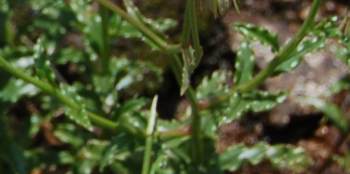Wahlenbergia cuspidata
Wahlenbergia cuspidata Brehmer
Family: Campanulaceae
Common names: None recorded
Introduction
Wahlenbergia cuspidata is a bushy, perennial herb with large, showy, cup-shaped flowers, from summer-rainfall regions of South Africa.

Description
Description
Wahlenbergia cuspidata is a showy, bushy, perennial herb, up to 600mm tall. Leaves are alternate, sessile, elliptic or lanceolate, hairy on both surfaces, with characteristic wavy margins.

Flowers are large, solitary on long stalks in lax inflorescences. Flower parts are in fives. The corolla is pale-blue and cup- shaped, petals are broad with prominent central veins. Calyx lobes are long, narrow and pointed, with toothed margins, fused into a hairless hypanthium. Stamens are free and the filaments bases are expanded to form a dome. The pistil has an inferior 2-locular ovary with many ovules, and a style with 2 or 3 lobes and pollen-collecting hairs on upper parts. Fruit is a capsule and opens by apical valves.

W. cuspidata flowers from November to March.
Conservation Status
Status
Wahlenbergia cuspidata is currently listed as LC (Least Concern) in the Red List of South African Plants. It is therefore considered not to be under any immediate risk of extinction from natural or anthropogenic activities.
Distribution and habitat
Distribution description
The species is endemic to South Africa and restricted to summer-rainfall regions. It is known from the Free State, KwaZulu-Natal and Eastern Cape, where it grows on mountains in damp rocky grassland, patches of riverine woodland, on the sides of streams and on bases of rocky ledges.
Derivation of name and historical aspects
History
The genus Wahlenbergia was named after Professor George Wahlenberg of the Botany Department at Uppsala University in Sweden. The species was described by Von Brehmer in 1915 based on Eastern Cape collections by Sunderland and Tyson in 1864 and 1886, respectively. At the same time Von Brehmer described the species W. dentifera and W. furcata from the Free State and KwaZulu-Natal. Later in 1986, O.M. Hilliard and B.L. Burtt considered them to be the same as W . cuspidata and retained the epithet cuspidata, referring to the long, narrow, tapering calyx lobes.
Ecology
Ecology
Wahlenbergia cuspidata relies on pollinator visitors for seed production. It maintains a generalised entomophilous system which is facilitated by the open regular flower design. Social honeybees and solitary Lipotriches bees are the main pollinators. The flowers offer nectar to the pollinators, which mostly visit when the flowers are in the female phase. The solitary Lipotriches bees frequently overnight on flowers.
Uses
Use
No cultural and medicinal uses are recorded.

Growing Wahlenbergia cuspidata
Grow
In gardens Wahlenbergia cuspidata is best planted in spring. It grows well in full sun to partial shade, in enriched, constantly moist soil. Plants require regular watering.
W. cuspidata can be propagated from seeds, divisions and basal cuttings. Seeds are sown in spring in well-drained soil. Seeds germinate in 18 to 24 days. Basal cutting are also taken in spring and should be treated with rooting hormones to encourage rooting.
References
- Hilliard, O.M. & Burtt, B.L. 1986. Notes on some plants of southern Africa chiefly from Natal. XII. Notes from the Royal Botanic Gardens Edinburgh 43: 195 - 198.
- Peter, C.G. & Johnson, S.D. 2008. Mimics and magnets: the importance of color and ecological facilitation in floral deception. Ecology 89,6: 1583 - 1595.
- Petterson, J.A. 1997. Revision of the genus Wahlenbergia (Campanulaceae) in New Zealand. New Zealand Journal of Botany 35,1: 9 - 54.
- Pooley, E. 1998. A field guide to wild flowers of KwaZulu-Natal and the Eastern Region. Natal Flora Publications Trust, ISBN 0 620 21500-1.
- Rix, M. 2004. Wahlenbergia hederacea (Campanulaceae). Curtis's Botanical Magazine. Plate 488.
- Welman, W.G. & Victor, J.E. 2006. Wahlenbergia cuspidata Brehmer. National Assessment: Red List of South African Plants version 2014.1.
- Weslford, M.R. & Johnson, S.D. 2011. Solitary and social bees as pollinators of Wahlenbergia (Campanulaceae): single-visit effectiveness, overnight sheltering and responses to flower colour. Arthropod -- Plant Interactions. DOI 10.1007/S11829-011-9149-0.
Credits
Thuli Makhoba
(KwaZulu-Natal Herbarium)
and
Christopher Cupido
(Compton Herbarium)
September 2014
Plant Attributes:
Plant Type: Perennial
SA Distribution: Eastern Cape, Free State, KwaZulu-Natal
Soil type:
Flowering season: Early Summer, Late Summer
PH:
Flower colour: Blue
Aspect:
Gardening skill: Challenging
Special Features:
Horticultural zones









Rate this article
Article well written and informative
Rate this plant
Is this an interesting plant?
Login to add your Comment
Back to topNot registered yet? Click here to register.